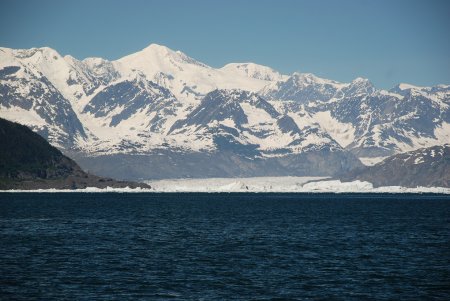
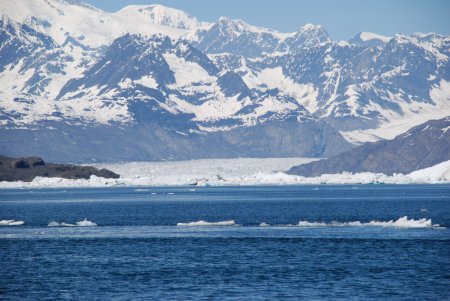
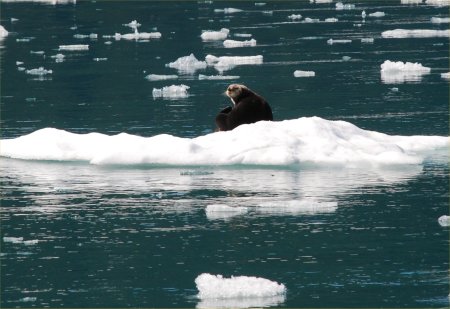
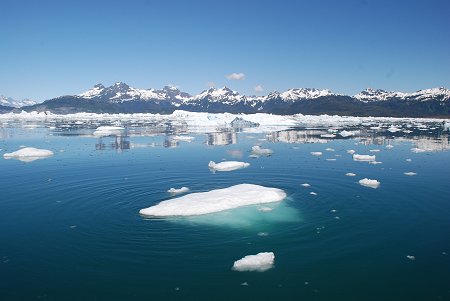
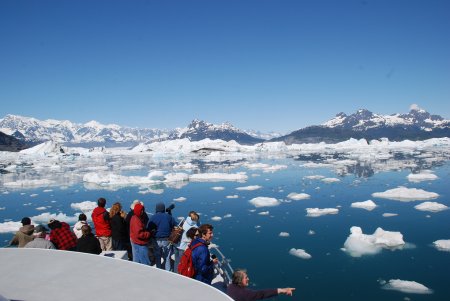
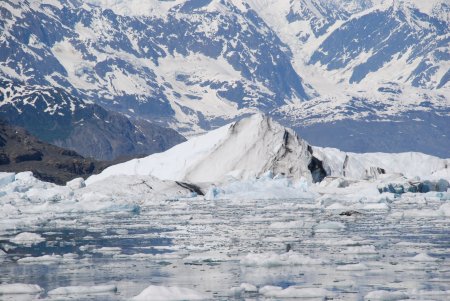
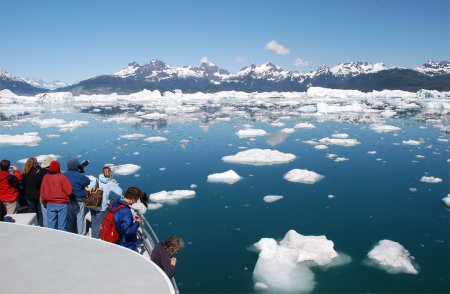
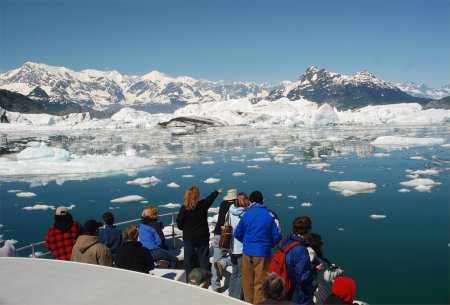
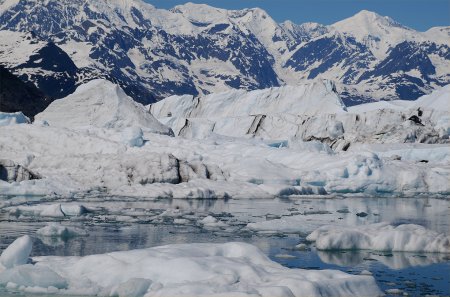
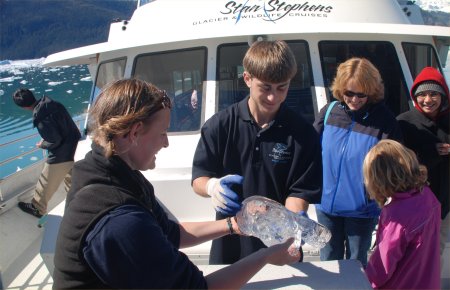
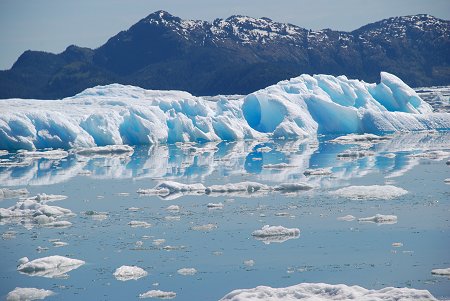
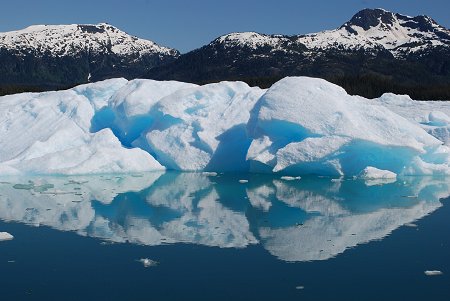
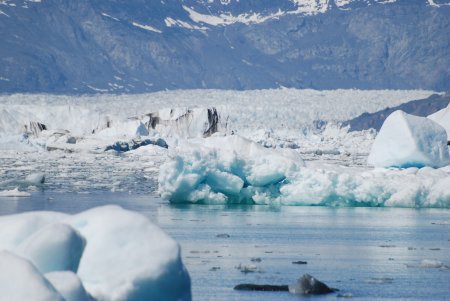
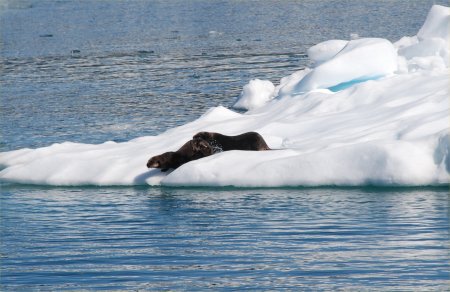
Columbia Glacier - Prince William Sound, Alaska - July 2, 2008
A Day Cruise out of Valdez, Alaska to The Columbia Glacier
ALL Photos © K. Dewey, School of Natural Resources, Applied Climate Sciences, UNL.
| The Columbia Glacier is an important tidewater glacier to
monitor because of its present rapid retreat, its generation of
icebergs, and its vicinity to oil-tanker traffic in and out of the Port
of Valdez, Alaska. It is the last tidewater glacier in North America. Sliding roughly 80 feet a day, the Columbia Glacier is among the world’s fastest-moving glaciers. Most importantly it has retreated over 9 miles (yes, NINE miles) in the time period 1980 through 2007). Note the links and further information after the photos showing the dramatic impact global warming is having in this part of the world. |
 |
 |
| Approaching the Columbia Glacier | Approaching the Columbia Glacier with the first small icebergs |
 |
 |
| A seal drifting along on a small ice berg | It is possible in this image to see the ice beneath the small iceberg |
 |
 |
| Click HERE for a much larger version of this image | Close up view of the leading edge of the Columbia Glacier |
 |
 |
| We explored the ice that was breaking off the glacier | We drifted around exploring the small icebergs |
 |
 |
| Up close to the leading edge of the glacier | A cruise staff member let us examine some of the glacial ice |
 |
 |
| The bright blue color is typical of glacial ice. | The bright blue color is typical of glacial ice. |
 |
 |
| The glacier can be seen in the distance behind the area breaking off | Two seals were frolicking on the ice bergs |
|
Alaska’s Columbia Glacier Continues on
Disintegration Course
Alaska’s rapidly disintegrating Columbia
Glacier, which has shrunk in length by nine miles since 1980, has
reached the mid-point of its projected retreat, according to a new
University of Colorado/Boulder study. Lead author Dr. Tad Pfeffer,
associate director of CU-Boulder’s Institute of Arctic and Alpine
Research, said the glacier is now discharging nearly two cubic miles
of ice annually into Prince William Sound, the equivalent of 100,000
ships packed with ice, each 500 feet long. The tidewater
glacier—which has its terminus, or end, in the waters of Prince
William Sound—is expected to retreat an additional nine miles in the
next 15 to 20 years before reaching an equilibrium point in shallow
water near sea level, he said.
The Columbia Glacier is now the single
largest glacial contributor to sea level in North America, producing
about 10 percent of the water volume entering the sea from all
Alaskan glaciers each year. Sliding roughly 80
feet a day, the Columbia Glacier is among the world’s fastest-moving
glaciers and the last of Alaska’s 51 tidewater glaciers to exhibit a
drastic retreat. The glacier’s retreat appears to be due to a
combination of complex physical processes. Dr. Pfeffer said, “The
start of the retreat in 1980 is not the direct result of global
warming, but was triggered by longer-term warming.... The Columbia
Glacier, like all Alaska glaciers, is melting at an increased rate,
but the enormous volume of loss accompanying the retreat is much
greater than melt alone.”
“When tidewater glaciers thin to a critical
level, they seem to reach a point where they speed up discharging
ice into the ocean and can’t slow down,” said Dr. Pfeffer. “Up until
about 50 years ago, the perception was that Greenland and Antarctica
were essentially monolithic pancakes of ice.... We now understand
that these large ice masses are made up of very different
sub-regions that respond uniquely to climate forcing.” The ongoing
research on the Columbia Glacier retreat can be used as a model for
the current behavior of glaciers in Greenland and Antarctica, where
more than 90 percent of the Earth’s ice is located.
LINKS to Additional Information: Time lapse of the Columbia Glacier rapidly retreating and calving Another Time lapse video of the Columbia Glacier rapidly retreating Recent Public Polling on Public Perception of Climate Change |